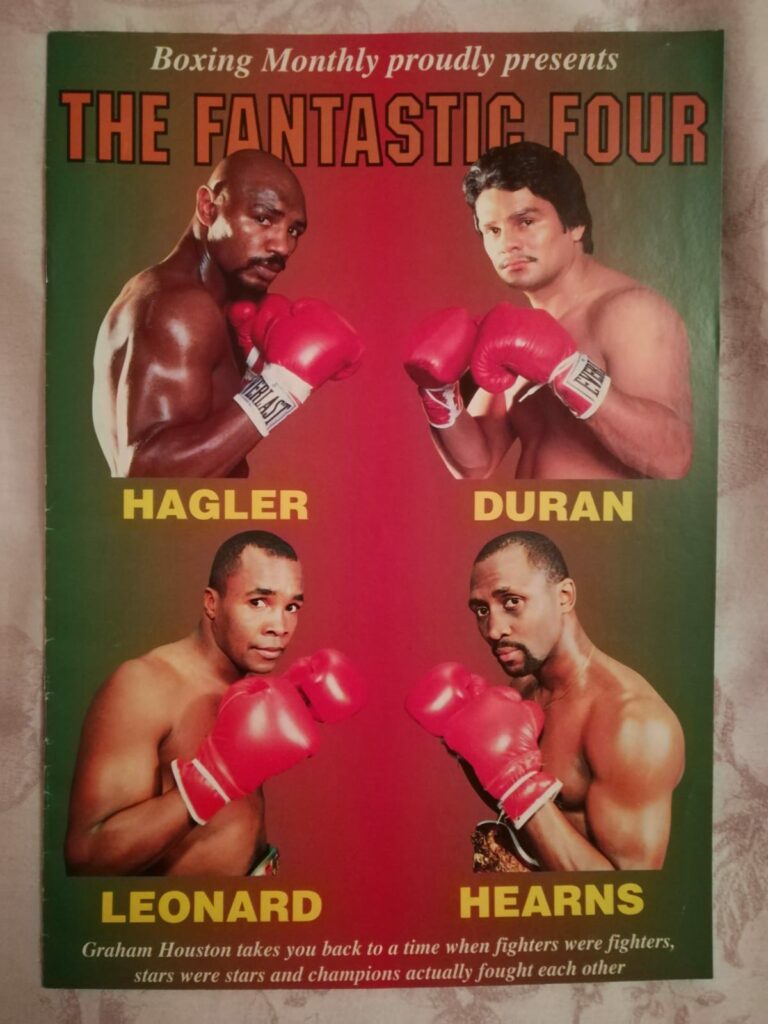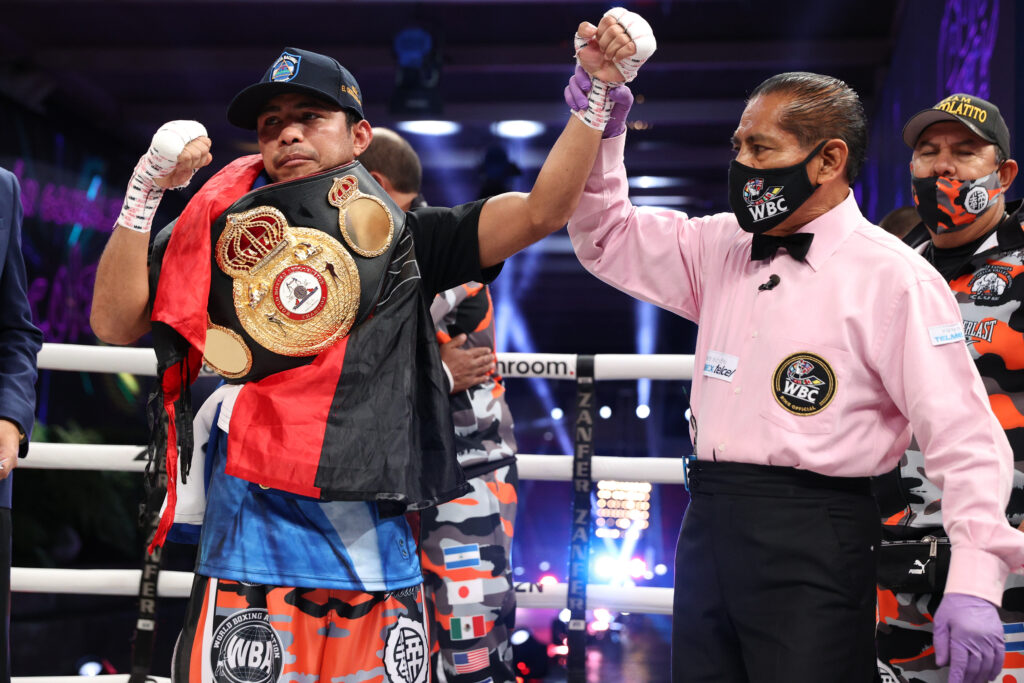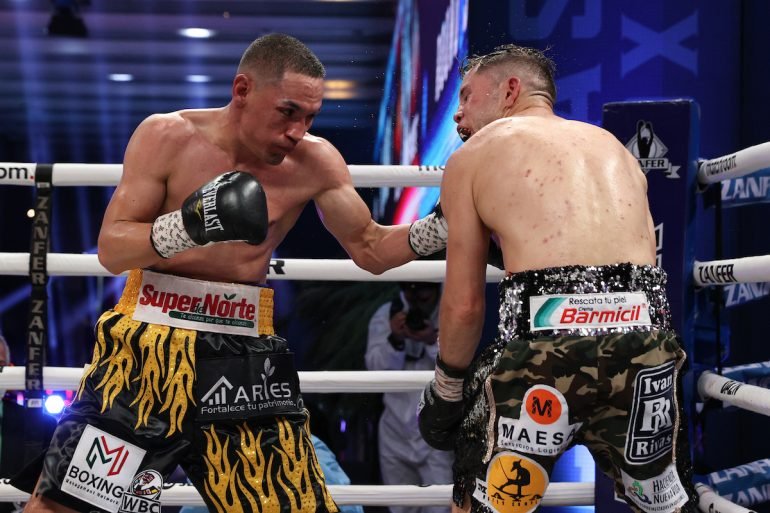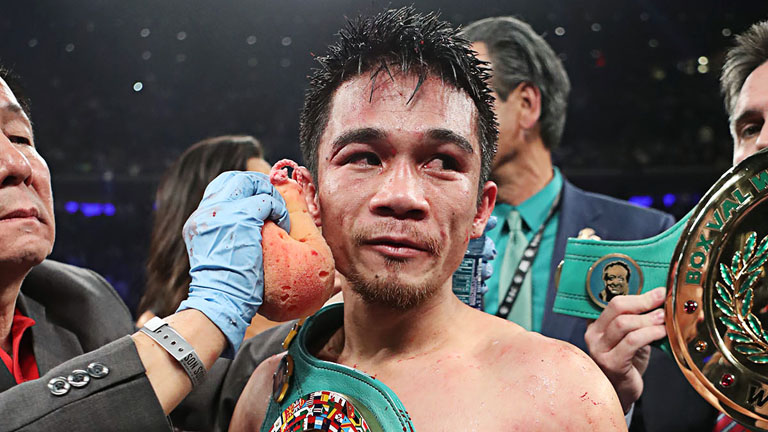Luke G. Williams argues that Roman Gonzalez, Juan Francisco Estrada, Srisaket Sor Rungvisai and Carlos Cuadras have proved themselves worthy of being anointed the modern-day successors to the original ‘Four Kings’…
It was the late, great journalist George Kimball who coined the phrase ‘Four Kings’ to describe the superlative quartet of boxers – Sugar Ray Leonard, Roberto Duran, Tommy Hearns and Marvin Hagler – whose extraordinary pugilistic prowess enraptured fight fans throughout the 1980s.
Before Kimball’s book of the same name hit bookshelves in 2008, a legendary 1990 VHS release had labelled this same grouping ‘The Fabulous Four’, while Boxing Monthly magazine went with ‘The Fantastic Four’ when producing a souvenir supplement celebrating their achievements.
Whichever moniker you prefer, there is unanimity of agreement that boxing undoubtedly benefited from the fact these four Hall of Famers battled each other an impressive nine times across an unofficial round robin of high-class match-ups throughout the 1980s.
The ‘Four Kings’ era began on June 20, 1980 in the Olympic Stadium in Montreal when Roberto Duran outslugged Sugar Ray Leonard over 15 rounds, and ended on December 7, 1989, when Leonard widely outpointed the Panamanian over 12 rounds at the Mirage Hotel in Las Vegas.
Across this time-span of nine-and-a-half years (or 3,458 days to be precise), the ‘Four Kings’ brought us controversy, violence of an intensity that has scarcely been witnessed before in the prize ring, spectacular knockouts, questionable judging and a great fighter quitting in circumstances that still defy belief.
In his book’s sub-title, Kimball labelled the age of the ‘Four Kings’ as ‘The Last Great Era of Boxing’, a melodramatic statement in line with a tendency towards premature obituary writing which has plagued boxing throughout its history. (As far back as 1895, heavyweight champion James J. Corbett declared: “Pugilism will not last. The people and the press are against it and in a year or two all there will be left of it will be an occasional encounter in a barn for a thousand dollars a side.”)
Despite the inherent pessimism of his sub-title, you can see where Kimball was coming from. Since the 1970s and ‘80s boxing has gradually retreated from its status as a staple of mainstream attention to a niche sport which occasionally breaks out to a wider audience. Nevertheless, the fetishisation of the ‘Four Kings’ era is a reflection of certain boxing fans’ and writers’ tendency to praise the past and lambast the present.
It’s all too easy to view the ‘Four Kings’ through rose-tinted spectacles and ignore some of the undoubted deficiencies of their rivalries.
For starters, Duran was too small to be a legitimate threat against Hagler or Hearns, really. He was one of the greatest lightweights of all time, most certainly, but he was well past his best when he took Hagler the distance in a disappointing fight in 1983 and even more so when knocked silly by Hearns in a brief slaughter in 1984.
As for Hagler, the fact he failed to fight any of the other ‘Kings’ more than once leaves several questions about the exact extent of his greatness frustratingly unanswered. His shoot-out with Hearns was a classic, but had they fought – as originally planned – in 1982, maybe we could have been granted a classic trilogy between the two men rather than a one-shot deal.
By the time Hagler and Leonard finally squared off in 1987 both men had probably peaked. The controversy of the judging in the Leonard-Hagler fight also undermines – to a certain extent – the idea that the ‘Four Kings’ operated in some utopian golden era.

combination of Duran, Hagler, Hearns and Leonard spelled greatness.
Juan Guerra’s 118-110 scorecard in favour of Leonard that night in Las Vegas remains as outrageous and egregious today as it was then, and the hotly debated split decision in Leonard’s favour left the duo’s rivalry crying out for a conclusive rematch. That Leonard-Hagler 2 never materialised left a bitter rivalry unfulfilled and unsettled.
Finally, it is often overlooked that the last two fights in the ‘Four Kings’ series – when Leonard was gifted a draw against Hearns and then outboxed the shell of a husk of what was once Duran – did little to enhance the reputation of any of those involved.
Please understand that none of this is said to undermine or diminish the ‘Four Kings’, whose array of rivalries are among the most compelling boxing has ever produced. Rather I make these points to emphasise that if we fall into the trap over over-idealising the past, then we often end up under-estimating the quality of what is on offer to us in the present.
And the fact is that right now we have a modern ‘Four Kings’ equivalent in the form of a quartet of fighters who may not enjoy mainstream adulation, but have arguably provided – pound-for-pound – more drama and pugilistic excellence than even Messrs Leonard, Duran, Hearns and Hagler combined to conjure in those nine iconic fights.
Of course, I’m not talking about Teofimo Lopez, Devin Haney, Ryan Garcia and Gervonta Davis – who have been prematurely anointed the ‘new Four Kings’ by some sections of the media despite the fact not a single fight has yet been brokered between any of them.
No, I’m talking about the superlative four-way rivalry between Roman Gonzalez, Juan Francisco Estrada, Srisaket Sor Rungvisai and Carlos Cuadras.
It’s a rivalry that has largely been fought out for the WBC’s 115lbs super-flyweight title, although it actually commenced on November 17, 2012 – when Gonzalez and a then largely unknown Estrada met in Los Angeles in a WBA light-flyweight title fight.

has been blessed with great rivals. Photo: Ed Mulholland/Matchroom Boxing.
When the duo rematch in Dallas on March 13 (3,039 days since their first meeting) the quartet of fighters, who have been dubbed ‘The Four Princes’ by writer Michael Rosenthal, will surpass the tally of nine fights mounted by the ‘Four Kings’.
With the winner of Gonzalez-Estrada 2 mandated by the WBC to face Srisaket later this year, there is every chance that the ‘Four Princes’ will continue to entertain boxing fans for a while to come, too.
WBC president Mauricio Sulaiman is adamant that the ‘Four Princes’ have created a series of fights that will live long in the annals of boxing.
“Fans love to see continuity,” Sulaiman told Boxing Social. “One fight that stands alone is good, but when you have a concept and a series of fighters that combine between them to fight many times it’s tremendous. It’s those combinations that create greatness.
“As well as the four ‘super kings’ [from the 1980s] we could also compare this era to the days of Humberto ‘Chiquita’ Gonzalez and Michael Carbajal, [who fought each other three times for the WBC and IBF light-flyweight titles in the 1990s], but the difference here is we have had more elements, more fighters, more combinations of fighters.”

Photo: Ed Mulholland/Matchroom Boxing.
As alluded to earlier, I believe that a case can be made that the rivalry between the ‘Four Princes’ has – in purely competitive terms – been of a higher quality than the ‘Four Kings’.
There have been no Leonard-Duran 3-style duds among their nine fights thus far and neither Gonzalez, Estrada, Srisaket nor Cuadras are far past their sell-by date as Leonard, Hearns and Duran were in 1989. They are also far better matched in terms of weight than the ‘80s ‘Four Kings’ were.
Of course, the ‘Four Princes’ haven’t achieved household name status or been granted ‘Sports Illustrated’ magazine cover stories in the same way that the ‘Four Kings’ did. Part of the reason for that is boxing’s diminished profile and part of the reason is the fact that two Mexican boxers, a Nicaraguan and a Thai are never going to attract the same column inches as three or four Americans – particularly when they campaign in weight classes that have traditionally struggled for attention.
With this in mind, it’s about time their accomplishments received a bit more in the way of wider attention and praise. Indeed, I would humbly suggest that labelling Gonzalez, Estrada, Rungvisai and Cuadras as ‘Four Princes’ actually does them a disservice.
This quality quartet truly deserve a more regal positioning in the history of boxing.
‘Four Kings Mark 2’?
‘Four Kings: the new generation’?
Call them what you like, but make sure you savour their complex and competitive rivalries and superlative talents while you can.
As Mauricio Sulaiman told Boxing Social: “This super-fly era is not yet over – there’s still a good two or three years of great fights between these fighters left. And I’m sure it will go on to be remembered as one of the best eras of lighter weight activity boxing has ever seen.”
The original Four Kings:
Duran W15 Leonard, June 20, 1980, WBC welterweight title.
Leonard TKO8 Duran, November 25, 1980, WBC welterweight title.
Leonard TKO14 Hearns, September 16, 1981, WBC/WBA welterweight titles.
Hagler W15 Duran, November 10, 1983, WBC/WBA/IBF middleweight titles.
Hearns KO2 Duran, June 15, 1984, WBC super-welterweight title.
Hagler KO3 Hearns, April 15, 1985, WBC/WBA/IBF middleweight titles.
Leonard W12 Hagler, April 6, 1987, WBC middleweight title.
Hearns D12 Leonard, June 12, 1989, WBC/WBO super-middleweight titles.
Leonard W12 Duran, December 7, 1989, WBC super-middleweight title.
Overall records of the original Four Kings against each other:
Leonard 4-1-1 (win percentage 67%).
Hagler 2-1 (67%).
Hearns 1-1-2 (25%).
Duran 1-4 (20%).
The new Four Kings:
Gonzalez W12 Estrada, November 17, 2012, WBA light-flyweight title.
Cuadras WTD8 Srisaket, May 31, 2014, WBC super-flyweight title.
Gonzalez W12 Cuadras, September 10, 2016, WBC super-flyweight title.
Srisaket W12 Gonzalez, March 18, 2017, WBC super-flyweight title.
Estrada W12 Cuadras, September 9, 2017.
Srisaket WKO4 Gonzalez, September 9, 2017, WBC super-flyweight title.
Srisaket W12 Estrada, February 24, 2018, WBC super-flyweight title.
Estrada W12 Srisaket, April 25, 2019, WBC super-flyweight title.
Estrada W11 Cuadras, October 23, 2020, WBC super-flyweight title.
Estrada v Gonzalez, March 13, 2021, WBC/WBA super-flyweight titles.
Overall records of the new Four Kings against each other (so far):
Estrada 3-2 (60%).
Rungvisai 3-2 (60%).
Gonzalez 2-2 (50%).
Cuadras 1-3 (25%).
Original Four Kings vs new Four Kings:
Fights: Original Four Kings – 9.
New Four Kings – 9 (with one further scheduled).
Rounds fought: Original Four Kings – 93.
New Four Kings – 95.
Stoppages: Original Four Kings – 4.
New Four Kings – 2.
Total world title belts at stake: Original Four Kings – 15.
New Four Kings – 10.
Time between first fight and last: Original Four Kings – 3,458 days.
New Four Kings – 3,039 (when Gonzalez and Estrada meet on March 13).

